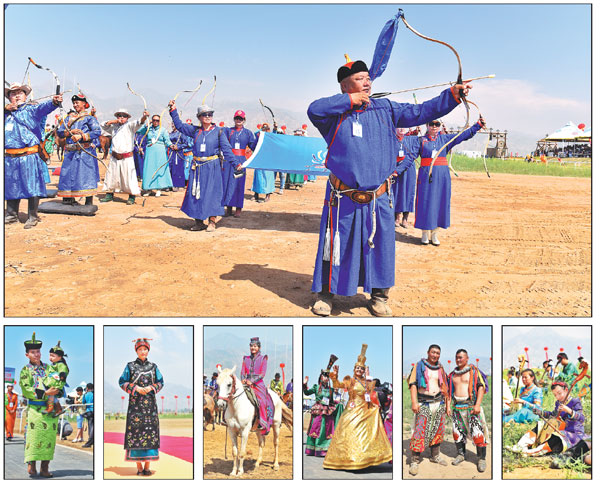Sampling a slice of mongolian culture
By Xing Yi/Yuan Hui (China Daily USA)
Updated: 2016-07-27
Since the days of Genghis Khan, competitors have gathered each summer to show off their skills in horseback riding, archery and wrestling. Xing Yi and Yuan Hui explore the scene in Hohhot.
Summer is the ideal time to visit the Inner Mongolia autonomous region, not only because the lush grasslands stretch as far as the eye can see, but also because it's a wonderful time to experience Mongolian culture as local people celebrate the traditional Naadam festival.
The festival is celebrated in a number of places. Typically, people from a neighborhood get together, but the gathering can even comprise thousands of people.
One of the places where Naadam - which runs from July 23 through July 29 - is celebrated is Chilechuan, a scenic spot in the Tumd Right Banner, 70 kilometers west of the capital Hohhot.
Naadam, which means game or competition in the Mongolian language, typically features three contests for men - horse riding, archery and wrestling.
The origins of the festival can be traced back to about 800 years, when Genghis Khan (1162-1227) ruled most of the northern Mongolian tribes.
Then, in order to inspect his army and unite the tribes, Genghis Khan used to organize gatherings of soldiers from different tribes to showcase their skills.
Over time, the festival has morphed into a cultural and sports event for locals and tourists.
As for the Naadam held in Chilechuan, nearly 1,000 competitors from around the region take part in the traditional Mongolian sports events.
"We brought 80 horses and 30 riders to compete," says Nars, the chairman of the horse association in Uxin Banner in Ordos, a prefecture-level city west of Hohhot.
In the past, people usually rode to the nearest pasture for Naadam, but nowadays they travel to different regions to compete for prizes and honor.
"There are more places which celebrate Naadam now compared with 10 years ago. Next month, we will attend a Naadam in Ordos," says Nars, whose team drove seven hours to attend the Chilechuan Naadam.
For Nominquluu, a 54-year-old Mongolian bow maker, Naadam is very important to preserve the Mongolian tradition of archery.
"Without the competition, the festival cannot be called Naadam," he says.
Traditional Mongolian archery requires a bow which is very different from its modern compatriot. It is made from a bull's horns and hardwood or bamboo without such parts as an aiming device or a shock absorber, and it requires more strength to use.
"Mongolian bows had disappeared after the 'cultural revolution' (1966-76), and so had the skill of traditional bow-making." says Nominquluu, who went to Mongolia to learn the lost craft in 2005, before becoming an active promoter of the skill.
As for other sports there is traditional Mongolian wrestling. Called bokh in the local language, it symbolizes strength and courage.
One of its defining features is the dance that the combatants perform as they enter or exit the arena. The dance has both physical and spiritual aspects; it helps the wrestlers show their respect for nature and their opponents, while providing a good warm-up.
Meanwhile, at Chilechuan, a Mongolian prayer ceremony is performed before the start of all competitions.
Erdeneqad, 51, who works at the Mausoleum of Genghis Khan, performs the ritual before a table that holds roast lamb, dairy products and parched rice.
During the ritual, a group of seniors utter chants which praise the feats of Genghis Khan.
"Not everyone can perform this ritual," says Erdenegad.
"The rituals require people with special training."
The opening ceremony of the Naadam at Chilechuan also saw a grand pageant of 600 ethnic Mongolians wearing traditional costumes, and a performance by Chinese, Mongolian and Russian singers.
Contact the writer at xingyi@chinadaily.com.cn
|
A Naadam festival in the Inner Mongolia autonomous region gathers participants from different regions who showcase their archery art and eyecatching costumes; and wrestlers compete for strength and courage and young musicians play matouqin, or horseheaded fiddle. Photos Provided To China Daily |

High-speed train debuts in Inner Mongolia
A bullet train departed Hohhot East Railway Station for Ulanqab marking the start of high-speed rail services using Inner Mongolia’s first newly-laid high-speed railway on Aug 3.

